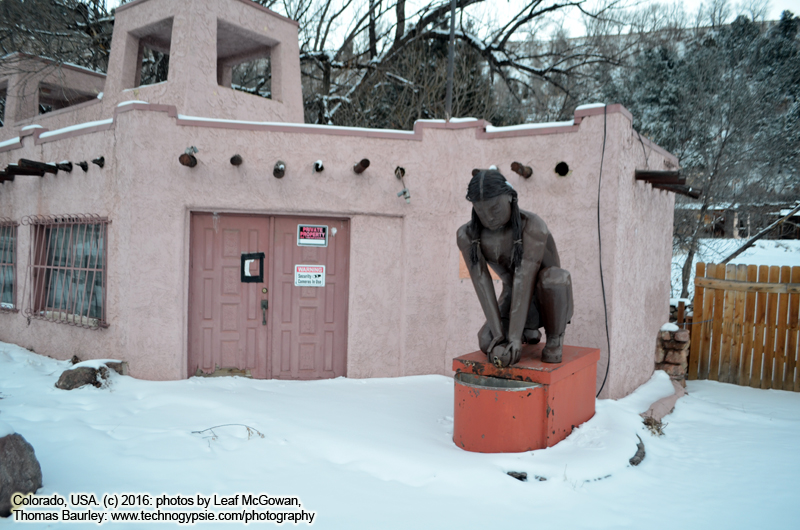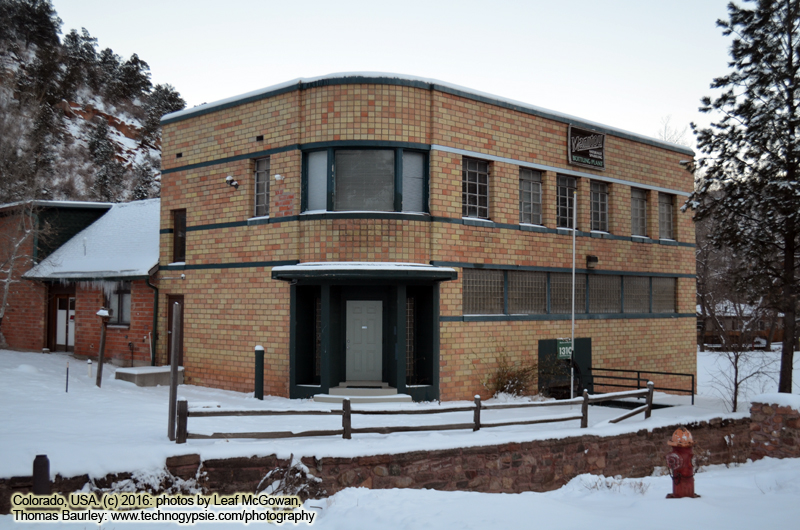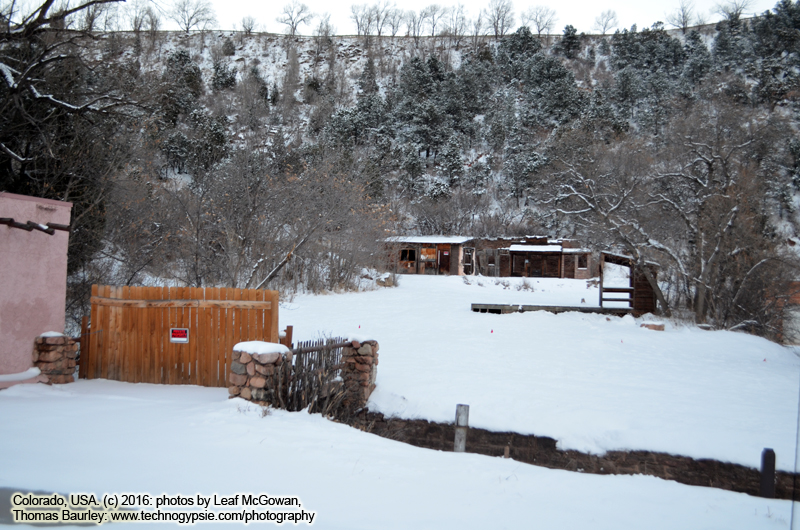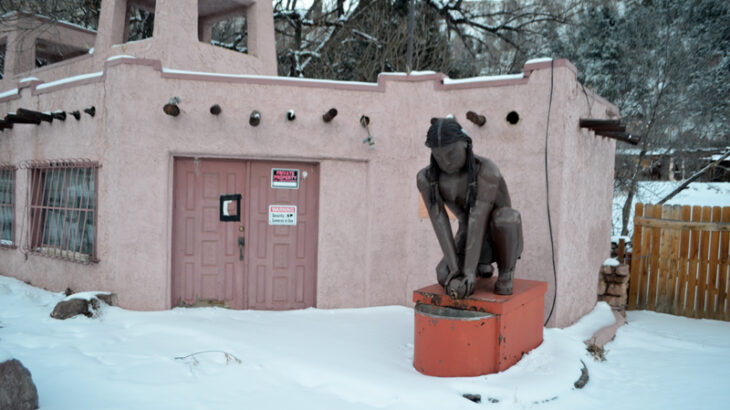
Old Chief Ute Spring
~ Manitou Avenue/Serpentine Road, Manitou Springs, Colorado ~
Article by Thomas Baurley, Leaf McGowan, Techno Tink Research
One of Manitou’s former famous springs now closed off to the public and no longer running. It was famous back then and was one of the sources for the “Ute Chief Mineral Water” and Manitou Springs bottling company. While it is no longer on the Springs trails given out by the Chamber of Commerce, its font still stands even though shut off.
It is located at the western end of Manitou Avenue and is privately owned. There are “no trespassing signs” dotting the fence and property, remnants of the decaying old water bottling plant in the backdrop. Fences surround the compound. The waters are dried up and no longer flow. Others say it was shut down several years ago because of safety concerns. When it did flow, the artist’s sculpture font was popular, depicting a Native American male taking of the waters (created by Steve Titus) and promoting the symbolic usage of the waters.
Jacob Schueler founded the Ute Chief Mineral Springs bottling works. When the water was flowing, users described its taste as similar to that of “Perrier” mineral water. It had the lowest mineral content in town, though 2 1/2 times lower than the minerals found in “Perrier,” hosting a TDS of 1,200. In 2003, the bottling plant was purchased by a Korean pharmacist named O Yoon Kwon, living in New York City. It began shipping water in 2006, primarily to Korea, but shipping, business, and economics made it difficult, although it was nicknamed the “World’s best water”. The Manitou Springs Foundation offered to take over the spring and refurbish the location, but the owner didn’t go with the proposal.
| Mineral | Amount | |
| Alkalinity | ||
| Calcium | ||
| Chloride | ||
| Copper | – | |
| Fluoride | ||
| Iron | ||
| Lithium | ||
| Magnesium | ||
| Manganese | – | |
| Potassium | ||
| Silica | ||
| Sodium | ||
| Sulfate | ||
| Zinc | ||
| Total Dissolved Solids |
Mineral spring comparison chart

The little touristy village of Manitou Springs is most famous for its mineral springs, which well up through eight (previously 10, upwards of 50) fonts peppered throughout the town. These springs are free to visit, and each holds its own variation of minerals, magic, folklore, and healing properties that visitors have sought throughout the ages. Each has its unique flavor, natural carbonation, and effervescence.
This valley was originally heavily frequented by various Native American tribes who visited Fountain Creek and its natural springs for their healing magic, offering homage and great respect to the spiritual powers that dwell here. They believed these magical springs were the gift of the Great Spirit Manitou, after which the town and valley were named. They brought their sick here for healing. The aboriginal inhabitants and visitors of the area called the “Great Spirit” as “Manitou”, and felt these mineral springs was its breath, as the source of the bubbles in the spring water. This made the waters and grounds extremely sacred. The Ute, Arapaho, Cheyenne, and many other tribes came here to partake of the great spirit’s breath. They would heal their sick here, collect the waters, stay for winters, and share in the waters as an area of peace where no conflict was allowed. There were believed to have been ten natural springs in the valley.
The Euro-Americans caused conflicts and skirmishes with the Natives, pushing them out so they could utilize the valley for business, resort, tourism, and commerce. It is said after the Natives left, they cursed the area for the Whites and that no company will ever succeed there. Ever since, it has been an ever-changing valley with businesses coming and going, failing and closing, and new ones coming in and replacing those that left. Stephen Harriman Long was one of the first white explorers to record the waters in 1820.
The expedition’s botanist and geologist, Edwin James, detailed the healing nature of the waters. The explorer George Frederick Ruxton wrote in his travel about these “boiling waters” as well that “… the basin of the spring was filled with beads and wampum, pieces of red cloth and knives, while the surrounding trees were hung with strips of deerskin, cloth, and moccasins”. This is a common practice to leave such similar objects, items, and cultural artifacts around the world at magical and healing springs, wells, and bodies of water.
Nearly 50 years later, Dr. William Abraham Bell and General William Jackson Palmer made plans to develop a health resort here during the Civil War with “a vision of dreamy summer villas nestled in the mountains with grand hotels and landscaped parks clustered around the springs” that they called “Fountain Colony” and “La Font”. It became Colorado’s first resort town. By 1871, white settlers began developing the area for tourism, health care, and profit.
A resort was soon developed here, taking advantage of the waters and incorporating them into medicinal and healing water therapies. This brought great prosperity to the region. By 1873, a developer named Henry McAllister, who worked for Palmer, spread the news about the medicinal benefits of the Springs and pushed for it to become a spa resort with an “incomparable climate and scenery” as its backdrop.
Then came various medicinal practitioners, such as Doctor Edwin Solly, who pushed the area as a resort for healing and therapy, preaching the combined waters to drink, soak in, and breathe of the pure air mixed with the sunny climate would be the most effective prescription to treat tuberculosis. The commercial businesses began to claim the various springs, enclosing some of them as the village grew. The first was the Cheyenne Spring House, which was established as a red sandstone bricked conical roofed structure.
Immediately after, over 50 wells and springs were drilled, many of which were enclosed. Once popularity disappeared and “dried up,” many of these springs were capped, paved over, and closed. However, as the fad died and medical centers and hospitals around the United States improved, Manitou became forgotten and suffered abandonment.
The Mineral Springs Foundation was formed in 1987 as an all-volunteer 501(c)3 non-profit to protect, improve, maintain, and manage the springs, with a goal of restoring some of them and promoting their popularity once again. They host walking tours called “Springabouts” every Saturday from Memorial Day to Labor Day, beginning downtown, and can be arranged by visiting the Tourist center or calling 719-685-5089.
Upon request, the visitor center will provide maps, brochures, detailed content charts, and sampling cups. They can also be found on their website at http://www.manitoumineralsprings.org. The series of springs has been developed as a National Register of Historic Places district and is located in one of the country’s largest districts of its kind. It was originally called the “Saratoga of the West” and established as a resort community within a spectacular setting at the edge of the Rocky Mountains along the base of Pikes Peak. Numerous bottling companies moved into the area, making a profit on the waters, the most famous of which was “Manitou Springs water,” and was sold globally.
Geology: The waters come from two sources in the Rampart Range and Ute Pass: “deep-seated waters” that travel through limestone caverns and drainage systems created by karst aquifers. The water dissolves the limestone and absorbs carbonic acid, carbon dioxide, and other minerals, making it “effervescent” or slightly naturally carbonated. Volcanic and inner core processes heat it.
Through time, the waters return to the surface naturally using an artesian process rising to the surface, collecting soda, minerals, and sodium bicarbonate upwards. The other water sources are from Fountain Creek and Williams Canyon, snowmelt, rainwater, and surface waters. The warm water then flows up into a limestone cavern where it becomes carbonated and springs forth to the surface in natural as well as human drilled locations. Most of these waters take thousands of years to complete their voyage from the mountain snow-capped peaks down to inner earth and back up to the surface – freeing its content and solutions from being affected by industry, development, and atmospheric contamination.
The Springs of Manitou:
http://www.technogypsie.net/naiads/?p=3203
- Cheyenne Spring – http://www.technogypsie.net/reviews/?p=4921 or http://www.technogypsie.net/naiads/?p=3133
This natural sweet soda spring comes up from limestone aquifers and is believed to be over 20,000 years old. - Iron Spring – http://www.technogypsie.net/naiads/?p=3159
The Iron Spring is named after its harsh, foul, iron-tasting flavor and content. It was a man-made spring drilled in the 1800s and prescribed to patients for iron deficiency. - Lithia / Twin Spring – http://www.technogypsie.net/reviews/?p=4881 or http://www.technogypsie.net/naiads/?p=3163
This is a combined location of two man-made drilled springs—Twin Springs and Lithia Springs. It is popular for its Lithium content and sweet taste, calcium, lithium, and potassium content. It’s popular to mix it in lemonade. - Navajo Spring – http://www.technogypsie.net/naiads/?p=3127
This is a natural soda spring over which commercial development was built. It is now within and beneath the popcorn and candy store. This was the most popular spring, frequented by Native Americans and early Euro-American settlers, and was the founding spring for the village. It originally fed a large bathhouse and bottling plant, bringing fame to the town. - Old Ute Chief Spring – http://www.technogypsie.net/naiads/?p=3169
- Seven Minute Spring – http://www.technogypsie.net/naiads/?p=3147
A man-made spring was drilled in 1909 to enhance the neighboring hotel’s tourist attraction. Its unique carbonization caused it to erupt like a geyser every 7 minutes. It became dormant until the 1990s when it was re-drilled, and the surrounding park was established. - Shoshone Spring – http://www.technogypsie.net/naiads/?p=3151
This was a natural spring that hosted sulfur content and was prescribed by various physicians for curative powers before modern medicine became popular and effective. - Soda Spring – http://www.technogypsie.net/naiads/?p=3217
- Stratton Spring – http://www.technogypsie.net/reviews/?p=4931 or http://www.technogypsie.net/naiads/?p=3139
This is a man-made drilled spring by the Stratton Foundation as a service to Manitou Springs village where tourists could come and partake of its waters, dedicated to early Native American Trails. - Wheeler Spring – http://www.technogypsie.net/naiads/?p=3155
This is another man-made drilled spring donated to the city by settler Jerome Wheeler of the New York Macy’s, who resided and banked in the town during the mining and railroad period. His former home is located where the current post office is today.
References:
- Gazette 2015 “List Manitou Springs”. Website referenced 12/21/16 at http://gazette.com/list-the-springs-of-manitou-springs/article/1565225.
- Harrison, Deborah 2003 “Manitou Springs”. Arcadia Publishing. ISBN 978-0-7385-2856-4.
- Manitou Springs Chamber of Commerce 2012 “The History of Manitou Springs”.
- Mineral Springs Foundation 2013 “Mineral Springs”. Website referenced 12/21/16 at http://www.manitoumineralsprings.org
- Manitou Mineral Springs 2015 “7 Minute Spring”. Website referenced 12/21/16 at http://manitoumineralsprings.org/7-minute-spring.html
- National Register 2013 “American Dreams – National Register of Historic Places in El Paso County, Colorado.
- Visit Colorado Springs 2016 “Manitou Mineral Springs”. Website referenced 12/21/16 at http://www.visitcos.com/manitou-mineral-springs.
- Wikipedia 2016 “Manitou Springs Mineral Springs”. Website referenced 12/21/16 at https://en.wikipedia.org/wiki/Manitou_Mineral_Springs

Discover more from The Naiads Well
Subscribe to get the latest posts sent to your email.

4 thoughts on “Old Ute Chief Spring (Manitou Springs, Co)”